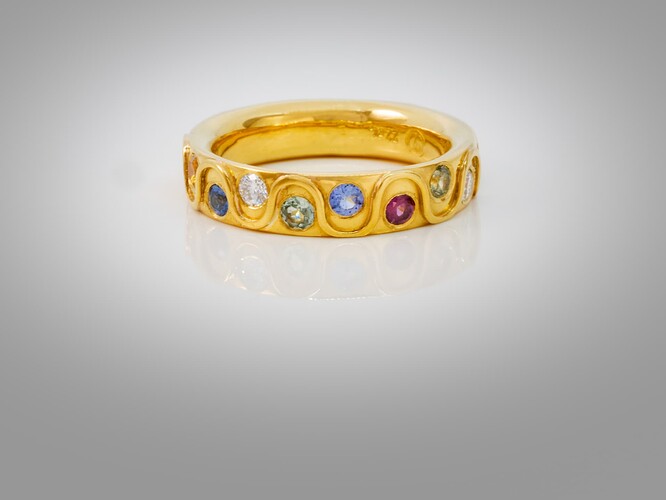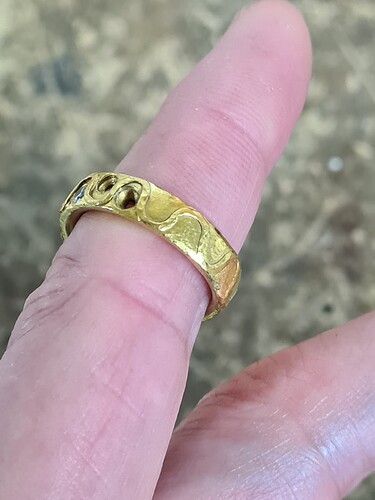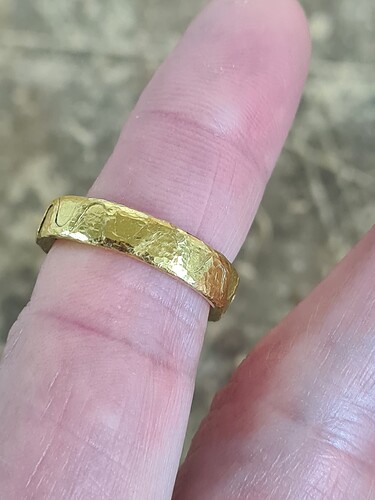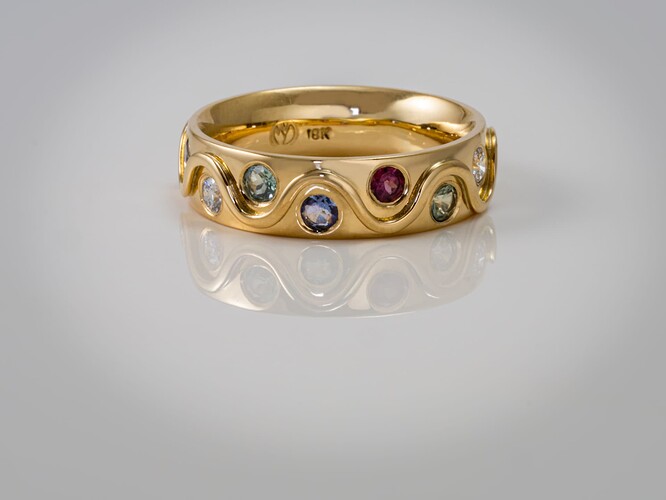I made a 24ct gold ring for a customer from her river gold and flush set it with a variety of gemstones representing her family. At the time of designing this I did tell her that this ring would be very soft and would be best if alloyed down to a lower carat, but she declined as she loves the rich colour of 24ct. She does not wear it all the time but 6 months ago I replaced one lost gemstone and now 2 others have fallen out. She now would like the ring to be alloyed down to a lower carat but would like to retain as much of the bright yellow of the gold.
So, my learned jewellers out there, would 22ct be OK or should I go with 18ct, or some other carat?
Many thanks
Mieke
You might make a lamination of the Fine Gold over 18ct , { .5 mm } & keep the color . Wraping the gold over the edge will hide the alloyed metal , Best Marcos.
Greetings Miele,
I work exclusively in 22 karat gold. We flush set stones frequently and as long as they are flush set a certain way they never fall out. I would be happy to share my method.
I would also be happy to assist you on how to alloy the 24 karat gold to 22 karat yellow gold. There is only a slight difference in color.
Take a look at my website:
And my instagram page:
@loisgore22
If you would like assistance let me know.
Best,
Lois
When we work with 24 kt we always fabricate rather than cast. My husband and I both wear 24 kt gold bands. We fabricated them a few sizes too small and then hammered and stretched them up to size. this hardens them up significantly.
As cast is too soft. 22kt is also quite rich in color. But again if there are stones involved I’d make it too small and stretch it up to work harden it. If you prefer to cast your mountings then just make them smaller and stretch it on a ring stretcher but be sure to allow for distortion of any design elements and to cut the stone seats after hardening.
Let us know how you wnet about redoing the ring and how the second try works out.
Jo
Nice idea about the overlay and would consider this apart from the ‘wave’ in the design. As you can see at the bottom of the ring this has been flattened and almost merged into the shank.
Thanks for the thoughts.
I was hoping you would put your 2 cents worth in Jo as your replies are always so informative.
The ring was fabricated but it I could not hammer harden as the ring has a ‘wave’ of gold soldered to it. May be I can heat harden?
Metal of 24K gold ring too soft
I’d like to talk about the notion that 24k is too “soft”. We use the terms “hard” & “soft” incorrectly. What we should be talking about is the malleability of the metal.
Hardness or softness is the ability to withstand a scratch, and has nothing to do with wearability. People will say 10K is harder than 14k, and 14K is harder than 18K, 22K or 24K; but they all scratch. 10K is stiffer, less malleable. The terms “hard” & “soft” are used to incorrectly to apply to wearability. “Harder,” 14K, is suppose to last longer than the “softer” metal 22K. In really it’s just the opposite.
Gold is a very dense metal, it is also very malleable and it’s beautiful. These are the qualities that make it valuable. Because of the density of 24K, Jo and her husband’s ring will out last the lesser karat gold rings. When one wears a very high karat gold, the surface will develop a patina, the metal moves because it’s malleable, but with 24K, the atomic bond of the pure metal is stronger and resist wear. With the lesser karat golds, the metal is wearing away because the density has been diluted with less dense metals, silver, copper, etc.
When I look at the pictures of the rings showing the missing stones, two things come to mind. The stones came out because the ring bent and the stones loosened in the their seats, or, the stones were broken out from your customer wearing another ring on their opposite hand and clapping. For six months of wear, even for 24k, the ring looks like someone took a hammer to it. I’ve seen this happen and the customer doesn’t even realize what they’ve done.
Most cultures that set stones in the higher karat gold, will use 18k, or 22k gold over the 24k for a couple of reasons. Adding a small amount alloy will cause the ring to be stiffer, less malleable and the workability is enhanced. Of course the more alloy that is added, the more diluted the color.
Tjones
Goldsmith
Good points Tjones. The ring is 18months ‘old’ - I should have said earlier, and yes the stones that are being lost are at the ends where the ring would bend the most. From what you are saying it definitely a good idea to alloy this gold down a tad. Thanks for your help.
I would highly suggest you talk to your customer about how she claps her hands. I’ve seen quite a few stones damaged and lost in this manner. And if this is indeed what’s happening, it won’t matter what the karat you make the ring out of, the damage will continue to occur. The pattern on the ring is very uniform, like something striking it. It looks very much like the way I would hammer finish a ring, only in this case the hammer is the ring on her opposite hand. I have also seen damage from someone tapping their steering wheel. This type of tapping would account for the pattern being flattened into the ring.
I just what to make it clear, when I was talking about hardness and softness, I wasn’t referring to work hardening the metal, that’s different than alloying the metal and changing the density and karat of the metal. When you work harden 24k, it will still be more malleable than an 18k or 22k ring, but compacting the crystal structure through work hardening (like stretching) will make it more resistant to the forces acting on it.
[
Hi Mieke,
I found this formula on another discussion. It’s the same one I use.
By Makena.
The classic 22k recipe is more like 33 grains of fine silver to 11 grains of copper for 1 troy ounce of gold. More silver in the recipe makes it malleable with lighter (green) color, more copper makes it redder in color and much less malleable.
Hi, a different tactic: I had some river gold, refined it and then alloyed it with platinum. The customer wanted a “white” color, so I used 20% Pt, but you can use as little as 7% and it will get quite hard and durable. I found this technique in an old handbook and was also guided by James Binion who was very kind and helpful.
Sandy
James is in the metals world “The Dude”.
He’s also a heck of a nice guy.
Thanks for the recipe. I also have come across this article Gold and Gold alloys see table 3, that describes 21ct as perhaps the best option for a high carat yellow gold. Much stronger than 22ct and a little softer than 18ct. I think I have gone down a rabbit hole with gold alloys ![]() - but so interesting.
- but so interesting.



